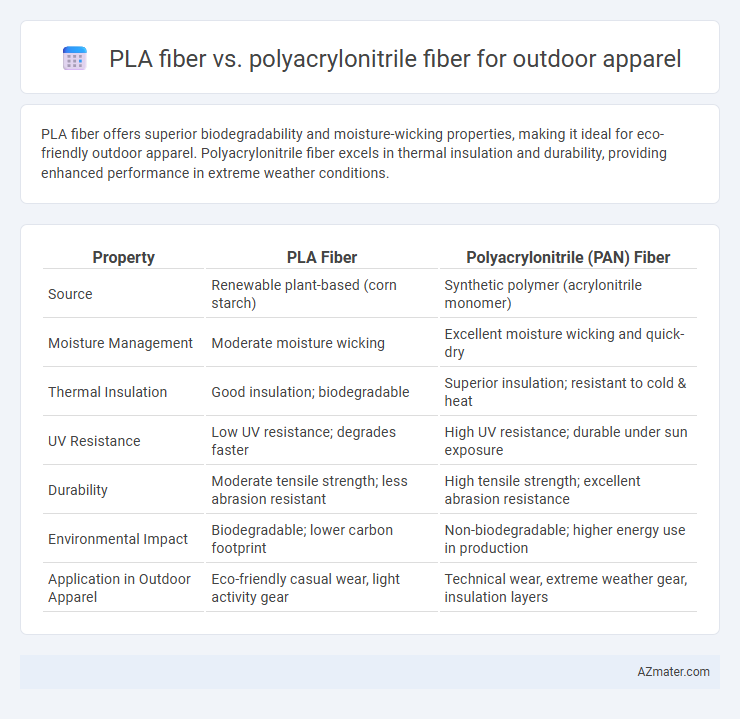PLA fiber offers superior biodegradability and moisture-wicking properties, making it ideal for eco-friendly outdoor apparel. Polyacrylonitrile fiber excels in thermal insulation and durability, providing enhanced performance in extreme weather conditions.
Table of Comparison
| Property | PLA Fiber | Polyacrylonitrile (PAN) Fiber |
|---|---|---|
| Source | Renewable plant-based (corn starch) | Synthetic polymer (acrylonitrile monomer) |
| Moisture Management | Moderate moisture wicking | Excellent moisture wicking and quick-dry |
| Thermal Insulation | Good insulation; biodegradable | Superior insulation; resistant to cold & heat |
| UV Resistance | Low UV resistance; degrades faster | High UV resistance; durable under sun exposure |
| Durability | Moderate tensile strength; less abrasion resistant | High tensile strength; excellent abrasion resistance |
| Environmental Impact | Biodegradable; lower carbon footprint | Non-biodegradable; higher energy use in production |
| Application in Outdoor Apparel | Eco-friendly casual wear, light activity gear | Technical wear, extreme weather gear, insulation layers |
Introduction to PLA and Polyacrylonitrile Fibers
PLA (Polylactic Acid) fiber is a biodegradable, renewable textile made from fermented plant starch, primarily corn, offering exceptional moisture-wicking and breathability ideal for outdoor apparel. Polyacrylonitrile (PAN) fiber, a synthetic polymer derived from acrylonitrile, boasts superior durability, thermal insulation, and resistance to weathering, making it a staple in performance outerwear. Both fibers serve distinct roles in outdoor clothing, with PLA emphasizing sustainability and comfort, while PAN focuses on long-lasting protection and structural integrity.
Key Properties of PLA Fiber
PLA fiber offers excellent moisture-wicking and biodegradability, making it an eco-friendly choice for outdoor apparel compared to polyacrylonitrile fiber, which excels in thermal insulation and flame resistance. Its inherent UV resistance and lightweight nature enhance comfort and durability in varying outdoor conditions. The natural origin of PLA fiber supports sustainability goals without compromising performance in breathability and odor control.
Key Properties of Polyacrylonitrile Fiber
Polyacrylonitrile (PAN) fiber, commonly known as acrylic fiber, offers superior thermal insulation and excellent moisture-wicking properties crucial for outdoor apparel. Its high resistance to UV degradation and colorfastness ensures durability and vibrant colors even under prolonged sun exposure. PAN fiber's low weight combined with softness provides comfort and protection, outperforming PLA fiber in maintaining structural integrity in harsh outdoor conditions.
Sustainability and Environmental Impact
PLA fiber, derived from renewable resources like corn starch, offers significant advantages in biodegradability and reduced carbon footprint compared to polyacrylonitrile (PAN) fiber, which is petroleum-based and non-biodegradable. PLA fibers decompose under industrial composting conditions, minimizing landfill waste and environmental pollution, whereas PAN fibers contribute to microplastic pollution and persistent environmental contamination. The production of PLA fiber utilizes less energy and emits fewer greenhouse gases, enhancing its sustainability profile for eco-conscious outdoor apparel manufacturing.
Moisture Management and Breathability
PLA fiber, derived from renewable resources like corn starch, exhibits superior moisture-wicking properties and enhanced breathability due to its hydrophilic nature, making it ideal for outdoor apparel. Polyacrylonitrile (PAN) fiber, commonly used in synthetic performance fabrics, offers moderate moisture management but tends to retain heat and moisture, reducing comfort during extended outdoor activities. PLA fibers promote quicker drying and better ventilation, providing improved thermal regulation compared to traditional polyacrylonitrile fibers in activewear designed for varying environmental conditions.
Durability and Weather Resistance
PLA fiber exhibits moderate durability but tends to degrade under prolonged exposure to moisture and UV radiation, making it less suitable for harsh outdoor conditions. Polyacrylonitrile fiber, commonly known as acrylic fiber, offers superior weather resistance with strong UV stability, excellent moisture-wicking properties, and higher abrasion resistance, making it ideal for outdoor apparel exposed to variable climates. The enhanced durability and resistance to environmental stressors of polyacrylonitrile fiber ensure longer-lasting performance in outdoor applications compared to PLA fiber.
Comfort and Skin Sensitivity
PLA fiber offers superior moisture-wicking and breathability compared to Polyacrylonitrile (PAN) fiber, enhancing comfort in outdoor apparel by effectively regulating body temperature. PLA's natural origin and hypoallergenic properties reduce the risk of skin irritation, making it ideal for sensitive skin in prolonged wear scenarios. Polyacrylonitrile fiber, while durable and resistant to environmental factors, tends to retain heat and may cause discomfort or itchiness for users with sensitive skin.
Insulation and Thermal Performance
PLA fiber offers excellent moisture-wicking properties and biodegradability, making it a sustainable option for outdoor apparel insulation. Polyacrylonitrile (PAN) fiber, commonly used in acrylic fabrics, provides superior thermal retention and durability under cold and wet conditions. PAN fibers excel in maintaining warmth due to their fine, dense structure, whereas PLA fibers prioritize breathability and environmental impact.
Cost and Market Availability
PLA fiber offers a cost-effective alternative to polyacrylonitrile (PAN) fiber due to its renewable raw material base and lower production expenses, making it increasingly attractive for sustainable outdoor apparel. Polyacrylonitrile fiber, widely used in high-performance outdoor gear, maintains a higher price point driven by complex manufacturing processes and superior durability, limiting its accessibility in budget-sensitive markets. Market availability favors PAN fiber with established supply chains and extensive usage, while PLA fiber is rapidly expanding in niche segments focused on eco-friendly and cost-conscious consumers.
Choosing the Best Fiber for Outdoor Apparel
PLA fiber offers excellent moisture-wicking properties and biodegradability, making it an eco-friendly option for outdoor apparel. Polyacrylonitrile fiber, commonly known as acrylic, provides superior insulation, durability, and resistance to UV rays, which enhances performance in harsh weather conditions. Selecting the best fiber depends on prioritizing sustainability and breathability with PLA or opting for warmth and long-lasting wear with polyacrylonitrile.

Infographic: PLA fiber vs Polyacrylonitrile fiber for Outdoor apparel
 azmater.com
azmater.com